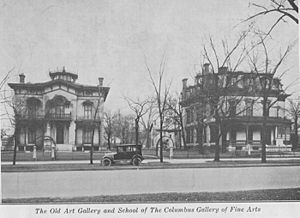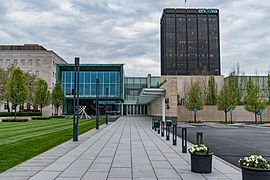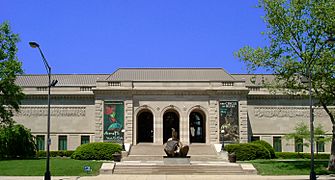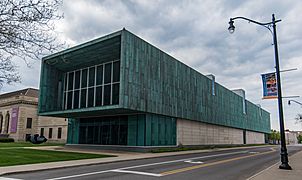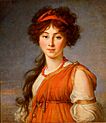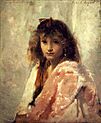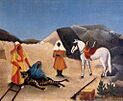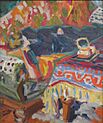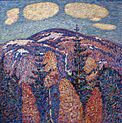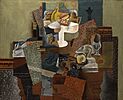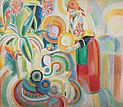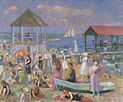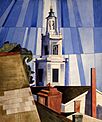Columbus Museum of Art facts for kids
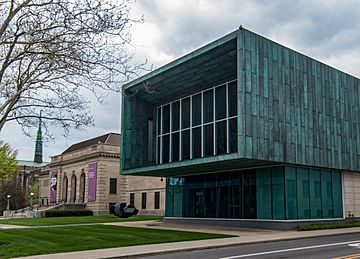 |
|
| Former name | Columbus Gallery of Fine Arts |
|---|---|
| Established | 1878 |
| Location | 480 E. Broad St., Columbus, Ohio 43215 United States |
| Type | Art museum |
| Public transit access | |
| Interactive map | |
| Area | Under 1 acre (0.40 ha) |
| Built | 1931 |
| Architect | Richards, McCarty and Bulford; Robert Aitken |
| Architectural style(s) | Second Renaissance Revival |
| Visitors | 254,092 (in 2022) |
| Designated | March 19, 1992 |
| Reference no. | 92000173 |
The Columbus Museum of Art (CMA) is a cool place to see art in downtown Columbus, Ohio. It started way back in 1878 as the Columbus Gallery of Fine Arts. It was the very first art museum in Ohio to officially register its charter. The museum collects and shows different kinds of art. You can see modern and contemporary art from America and Europe. They also have folk art, glass art, and amazing photographs. Since 2023, Brooke Minto has been the museum's Executive Director.
Contents
History of the Museum
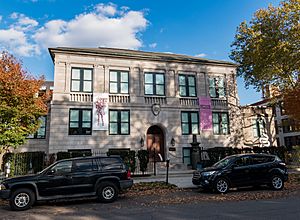
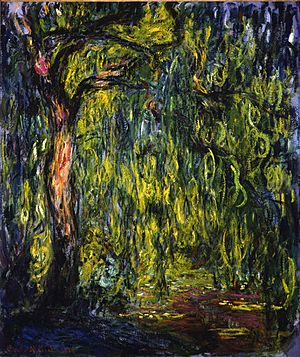
The CMA began its journey in 1878. It was first known as the Columbus Gallery of Fine Arts. From 1919, the museum was located in the Francis C. Sessions house. Mr. Sessions was a founder of the Columbus Art School. He gave his mansion and land to the art museum. The museum stayed there until 1923. Then, the house was taken down. The current museum building was built right on that spot. Some parts of the old Sessions house, like its entrance, are now in the museum's Beaton Hall.
The building you see today was built between 1929 and 1931. It officially opened its doors on January 22, 1931. In 1974, a new part was added to the back of the building. On March 19, 1992, the museum building was added to the National Register of Historic Places. This is a list of important historical places.
The Columbus Museum of Art started a big renovation and expansion in 2007. The first new area opened on January 1, 2011. This new space is called the Center for Creativity. It is a large area where visitors can do hands-on activities. It has galleries, places to gather, and workshops. On October 25, 2015, the new Margaret M. Walter Wing opened. This added a lot more space to the museum. It also updated many parts of the older building.
In September 2018, the Pizzuti Collection was given to the CMA. This was a museum in the Short North area. It also included some of its art collection. The Pizzuti Collection then became a part of the Columbus Museum of Art. Both locations temporarily closed in March 2020. This was due to the COVID-19 pandemic. The Columbus Museum of Art is also part of the Monuments Men and Women Museum Network. This network started in 2021.
The Ross Building: Design and Art
The main museum building from 1931 is now called the Elizabeth M. and Richard M. Ross Building. It was designed by architects from Columbus. They used a style called Second Renaissance Revival. The building has a strong concrete base. Its walls are made of limestone and concrete. The roof is copper and slopes inward.
The building is wide and has two stories. A central part sticks out a bit from the two sides. These sides have large limestone carvings. They are known as The Frederick W. Schumacher Frieze or Masters of Art. This artwork was created by Robert Ingersoll Aitken. It shows 68 artists from ancient times up to 1925.
The original main entrance has three arched doorways. The front of the building here has fancy decorations. These include special moldings and stone blocks. A carving above the arches used to say "Columbus Gallery of Fine Arts". Sixteen limestone steps lead up to the sidewalk. Two Italian-style lamp posts stand on either side.
The Center for Creativity is on the first floor of the museum. It has several fun areas. These include a Creativity Lounge and The Studio. There's also The Wonder Room, the Big Idea Gallery, and an Open Gallery.
Building Gallery
Art Collections
The museum's permanent collection has many amazing artworks. These include American and European modern art from the late 1800s and early 1900s. Some important collections are the Ferdinand Howald Collection. It has early Modernist paintings. The Sirak Collection features Impressionist and Expressionist art. There's also the Photo League Collection. The Philip and Suzanne Schiller Collection shows American Social Commentary Art. The museum also has the largest collections of art by Columbus-born artists. These include Aminah Brenda Lynn Robinson, Elijah Pierce, and George Bellows.
Some famous artworks you can see include early Cubist paintings by Pablo Picasso and Juan Gris. There are also works by François Boucher, Paul Cézanne, Mary Cassatt, Jean Auguste Dominique Ingres, Edgar Degas, Henri Matisse, Claude Monet, Edward Hopper, and Norman Rockwell. You can also see special art installations by Mel Chin, Josiah McElheny, Susan Philipsz, and Allan Sekula.
The museum also has many sculptures. Some of these are Hare on Ball and Claw and Intermediate Model for the Arch. Others include Out of There and The Family of Man: Figure 2, Ancestor II. You can also see The Mountain, Three-Piece Reclining Figure: Draped 1975, Two Lines Up Excentric Variation VI, and Wasahaban. You can explore the entire collection on the museum's website.
Art from the Collection
-
Anthony van Dyck, Christian Bruce, 1635
-
Elisabeth Vigée-Lebrun, Varvara Naryshkina, 1800
-
Rosa Bonheur, The Coal Carriers, 1851
-
Winslow Homer, Haymaking, 1864
-
Albert Bierstadt, Landscape, c. 1867–1869
-
Camille Corot, The Little Bird Nesters, 1873
-
Albert Pinkham Ryder, Spirit of Autumn, 1875
-
Pierre-Auguste Renoir, Madame Henriot 'en travesti' (The Page), 1875–76
-
Paul Cézanne, portrait of Victor Chocquet, 1877
-
John Singer Sargent
Carmela Bertagna
Oil on canvas, 1879 -
Mary Cassatt, Susan Comforting the Baby No. 1, c. 1881
-
William Michael Harnett, After the Hunt, 1883
-
Claude Monet, The Mediterranean (Cap d'Antibes), 1888
-
Henri Rousseau, Tiger Hunt, c. 1895
-
Mary Cassatt
Portrait of a Young Woman, Pastel on paper, 1898 -
Ernst Ludwig Kirchner, Girl Asleep, 1905–06
-
Juan Gris, Glass of Beer and Playing Cards, 1914
-
Jacques Villon, Portrait de M. J. B. peintre (Jacques Bon), 1914
-
Pablo Picasso, Nature morte au compotier (Still Life with Compote and Glass), oil on canvas, 1914–15
-
George Wesley Bellows, Riverfront No. 1, 1915
-
Charles Sheeler, Lhasa, 1916
-
Robert Delaunay, Portuguese Woman, Oil on canvas, 1916
-
Charles Demuth, The Tower, 1920
See also
 In Spanish: Museo de Arte de Columbus para niños
In Spanish: Museo de Arte de Columbus para niños


